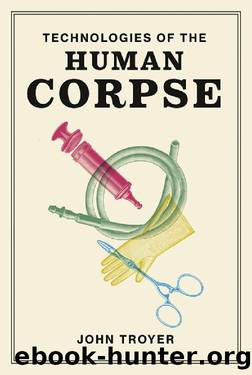Technologies of the Human Corpse by John Troyer

Author:John Troyer [Troyer, John]
Language: eng
Format: epub
Tags: Human corpse; corpse; dead body; death; dying; technology; embalming; death photography; postmortem photography; postmortem; AIDS; HIV; HIV/AIDS; Body Worlds; Gunther von Hagens; body brokers; organ trafficking; human tissue trafficking; funeral industry; funeral homes; funeral directors; disposal technology; biopolitics; necropolitics; thanatopolitics; bioethics; science and technology studies; happy death movement; death positivity; transhumanism; death law; patent law; funeral planning; grief; bereavement; Foucault; Agamben; Catherine Waldby; Judith Butler; Centre for Death and Society
Publisher: MIT Press
Published: 2020-03-13T00:00:00+00:00
Henry Reid, Ernest Nelson, and the UCLA Medical School
In March 2004, Henry Reid, the overseer and central administrator of the University of California at Los Angelesâs Willed Body Program, was arrested for providing human cadavers to another man, Ernest Nelson, for the purpose of dissection. Mr. Nelson then sold the body parts removed from the cadavers, by his own admission, to ââgiantâ medical research companies.â23 In response to the arrests, the UCLA medical school temporarily suspended acceptance of any new bodies to its cadaver program and began a full investigation into how this trafficking in human body parts could have ever occurred. This very publicly announced investigation began even as Ernest Nelson repeatedly explained to reporters that âmedical school officials gave him access to the universityâs body freezer twice a week, where he was allowed to saw off knees, hands, torsos, heads, and other body parts.â24 Goodwin gives the following details about the case as well as raising some broader necroeconomy issues: âAmong Nelsonâs clients was the Fortune 500 pharmaceutical giant, Johnson & Johnson. Johnson & Johnsonâs subsidiary, Mitek, obtained tissue from Nelson in the 1990s ... UCLA is simply the canary in the coalmine. Other medical schools, university hospitals, and organ procurement organizations are known to engage in such clandestine transactions.â25 Johnson & Johnson quickly responded to the UCLA case. A spokesperson explained that while its subsidiary Mitek did in fact purchase postmortem biomaterials from Nelson, âMitek did not knowingly receive samples that may have been obtained in an inappropriate way.â26 The spokespersonâs response led to two persistent and unanswered follow-up questions: Where exactly did the company believe the postmortem body parts originated? And, did anyone ever ask?
After further investigation by authorities, both men were criminally charged in March 2007 with conspiracy and grand theft, and Mr. Nelson was charged with tax evasion on the over one million dollars that he made by selling human body parts to âmore than 20 private medical, pharmaceutical and hospital research companies.â27 Reid pleaded guilty in October 2008 âto one count of conspiracy to commit grand theft, with a special accusation that he damaged or destroyed more than $1 million worth of school property, which refers to the donated bodies.â28 Finally, in May 2009, Ernest Nelson was found guilty of conspiring to commit grand theft, embezzlement, and tax evasion and in June 2009 sentenced to ten years in prison. He was also ordered to pay fines, penalties, restitution, and back taxes, which totaled more than $1.7 million.
Download
This site does not store any files on its server. We only index and link to content provided by other sites. Please contact the content providers to delete copyright contents if any and email us, we'll remove relevant links or contents immediately.
| Automotive | Engineering |
| Transportation |
Whiskies Galore by Ian Buxton(41935)
Introduction to Aircraft Design (Cambridge Aerospace Series) by John P. Fielding(33085)
Small Unmanned Fixed-wing Aircraft Design by Andrew J. Keane Andras Sobester James P. Scanlan & András Sóbester & James P. Scanlan(32763)
Craft Beer for the Homebrewer by Michael Agnew(18193)
Turbulence by E. J. Noyes(7977)
The Complete Stick Figure Physics Tutorials by Allen Sarah(7334)
Kaplan MCAT General Chemistry Review by Kaplan(6896)
The Thirst by Nesbo Jo(6876)
Bad Blood by John Carreyrou(6580)
Modelling of Convective Heat and Mass Transfer in Rotating Flows by Igor V. Shevchuk(6406)
Learning SQL by Alan Beaulieu(6235)
Weapons of Math Destruction by Cathy O'Neil(6204)
Man-made Catastrophes and Risk Information Concealment by Dmitry Chernov & Didier Sornette(5951)
Digital Minimalism by Cal Newport;(5698)
Life 3.0: Being Human in the Age of Artificial Intelligence by Tegmark Max(5506)
iGen by Jean M. Twenge(5384)
Secrets of Antigravity Propulsion: Tesla, UFOs, and Classified Aerospace Technology by Ph.D. Paul A. Laviolette(5330)
Design of Trajectory Optimization Approach for Space Maneuver Vehicle Skip Entry Problems by Runqi Chai & Al Savvaris & Antonios Tsourdos & Senchun Chai(5036)
Pale Blue Dot by Carl Sagan(4947)
